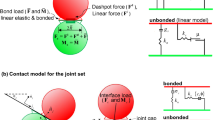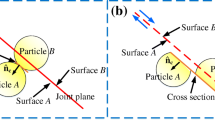Abstract
It is of great importance to study the failure process and scale effect of jointed rock mass in the field of rock mechanics and mining engineering. In the present paper, initially the uniaxial compression test on granite was performed and acoustic emission (AE) sequence was acquired during the compression process in laboratory. Results from numerical simulations using the particle flow code in two dimensions (PFC2D) were presented, and compared with experimental measurements. It was observed that the approach was reasonably good in predicting the real response of granite rock samples. The mechanical parameter of joint model was then calibrated based on PFC2D model with experimental results. Finally the mechanical properties of complex rocks with discrete fracture network (DFN) were studied and scale effects on the elasticity and strength were then investigated. The result showed that the failure pattern was similar when the ratio of joint contact bond strength (both shear and normal) to rock contact bond strength was in the range of 3~9%. The elastic modulus and strength parameters were changed with the sizes of rock sample for DFN models. Moreover, the variation of rock failure pattern under different sizes was also studied and finally the representative elementary volume (REV) size of the considered rock mass was estimated to be 9 × 9 m. It is suggested that the failure pattern analysis should be considered in the REV study of jointed rock mass.
Similar content being viewed by others
References
Bahaaddini, M., Hagan, P.C., Mitra, R., and Hebblewhite, B.K., 2014, Scale effect on the shear behaviour of rock joints based on a numerical study. Engineering Geology, 181, 212–223.
Cho, J.W., Kim, H., Jeon, S., and Min, K.B., 2012, Deformation and strength anisotropy of Asan gneiss, Boryeong shale, and Yeoncheon schist. International Journal of Rock Mechanics and Mining Sciences, 50, 158–169.
Cho, N., Martin, C.D., and Sego, D.C., 2007, A clumped particle model for rock. International Journal of Rock Mechanics and Mining Sciences, 44, 997–1010.
Cundall, P.A. and Strack, O.D., 1979, A discrete numerical model for granular assemblies. Geotechnique, 29, 47–65.
Dershowitz, W.S. and Einstein, H.H., 1988, Characterizing rock joint geometry with joint system models. Rock Mechanics and Rock Engineering, 21, 21–51.
Fakhimi, A. and Gharahbagh, E.A., 2011, Discrete element analysis of the effect of pore size and pore distribution on the mechanical behavior of rock. International Journal of Rock Mechanics and Mining Sciences, 48, 77–85.
Funatsu, T. and Shimizu, N., 2011, Numerical simulation of crack propagation in rock by clumped particle model. In: Qian, Q.H. and Zhou, Y.X. (eds.), Proceedings of the 12th ISRM International Congress on Rock Mechanics: Harmonising rock engineering and the environment, Beijing, Oct. 18–21, p. 387–390.
Hazzard, J.F. and Young, R.P., 2000, Simulation acoustic emissions in bonded-particle models of rock. International Journal of Rock Mechanics and Mining Sciences, 37, 867–872.
Holt, R.M., Kjølaas, J., Larsen, I., Li, L., Pillitteri, A.G., and Sønstebø, E.F., 2005, Comparison between controlled laboratory experiments and discrete particle simulations of the mechanical behaviour of rock. International Journal of Rock Mechanics and Mining Sciences, 42, 985–995.
Itasca Consulting Group, Inc., 2004, Particle Flow Code in 2-Dimensions, Command Reference version 3.1. Minneapolis. Itasca Consulting Group, Inc., 2004, Particle Flow Code in 2-Dimensions, Theory and Background v3.1. Minneapolis.
Ivars, D.M., Pierce, M.E., Darcel, C., Montes, J.R., Potyondy, D.O., Young, R.P., and Cundall, P.A., 2011, The synthetic rock mass approach for jointed rock mass modeling. International Journal of Rock Mechanics and Mining Sciences, 48, 219–244.
Lee, S.E. and Jeong, G.C., 2015, Numerical analysis on micro-damage in bisphere model of granitic rock. Geosciences Journal, 19, 135–144.
Pariseau, W.G., Puri, S., and Schmelter, S.C., 2008, A new model for effects of impersistent joint sets on rock slope stability. International Journal of Rock Mechanics and Mining Sciences, 45, 122–131.
Park, B. and Min, K., 2012, Discrete element modelling of shale as a transversely isotropic rock. 7th Asian Rock Mehcanics Symposium on the Present and Future of Rock Engineering, Seoul, Oct. 15–19, p. 336–342.
Potyondy, D.O. and Cundall, P.A., 2004, A bonded-particle model for rock. International Journal of Rock Mechanics and Mining Sciences, 41, 1329–1364.
Sarfarazi, V., Ghazvinian, A., Schubert, W., Blumel, M., and Nejati, H.R., 2014, Numerical simulation of the process of fracture of echelon rock joints. Rock Mechanics and Rock Engineering, 47, 1355–1371.
Wang, C., Tannant, D.D., and Lilly, P.A., 2003, Numerical analysis of the stability of heavily jointed rock slopes using PFC2D. International Journal of Rock Mechanics and Mining Sciences, 40, 415–424.
Wang, P.T., Yang, T.H., Yu, Q.L., Liu, H.L., and Zhang, P.H., 2013, Characterization on jointed rock masses based on PFC2D. Frontiers of Structural and Civil Engineering, 7, 32–38.
Wang, P.T., Yang, T.H., Xu, T., Yu, Q.L., and Liu, H.L., 2013, A Model of Anisotropic Property of Seepage and Stress for Jointed Rock Mass. Journal of Applied Mathematics, 2013, Article ID420536, 19 p.
Wasantha, P.L.P., Ranjith, P.G., Xu, T., Zhao, J., and Yan, Y.L., 2014, A new parameter to describe the persistency of non-persistent joints. Engineering Geology, 181, 71–77.
Xu, T., Ranjith, P.G., Wasantha, P.L.P., Zhao, J., Tang, C.A., and Zhu, W.C., 2013, Influence of the geometry of partially-spanning joints on mechanical properties of rock in uniaxial compression. Engineering Geology, 167, 134–147.
Yoon, J., 2007, Application of experimental design and optimization to PFC model calibration in uniaxial compression simulation. International Journal of Rock Mechanics and Mining Sciences, 44, 871–889.
Zhang, X.P. and Wong, L.N.Y., 2013, Crack initiation, propagation and coalescence in rock-like material containing two flaws, a numerical study based on bonded-particle model approach. Rock Mechanics and Rock Engineering, 46, 1001–1021.
Zhao, Y.L., Wan, W., Wang, W.J., Wang, M., and Peng, Q.Y., 2013, Fracture experiments on ordered multi-crack body in rock-like materials under uniaxial compression and numerical simulation of wing cracks. Chinese Journal of Geotechnics and Engineering, 35, 2097–2109. (in Chinese)
Author information
Authors and Affiliations
Corresponding author
Rights and permissions
About this article
Cite this article
Wang, P., Yang, T., Xu, T. et al. Numerical analysis on scale effect of elasticity, strength and failure patterns of jointed rock masses. Geosci J 20, 539–549 (2016). https://doi.org/10.1007/s12303-015-0070-x
Received:
Accepted:
Published:
Issue Date:
DOI: https://doi.org/10.1007/s12303-015-0070-x




